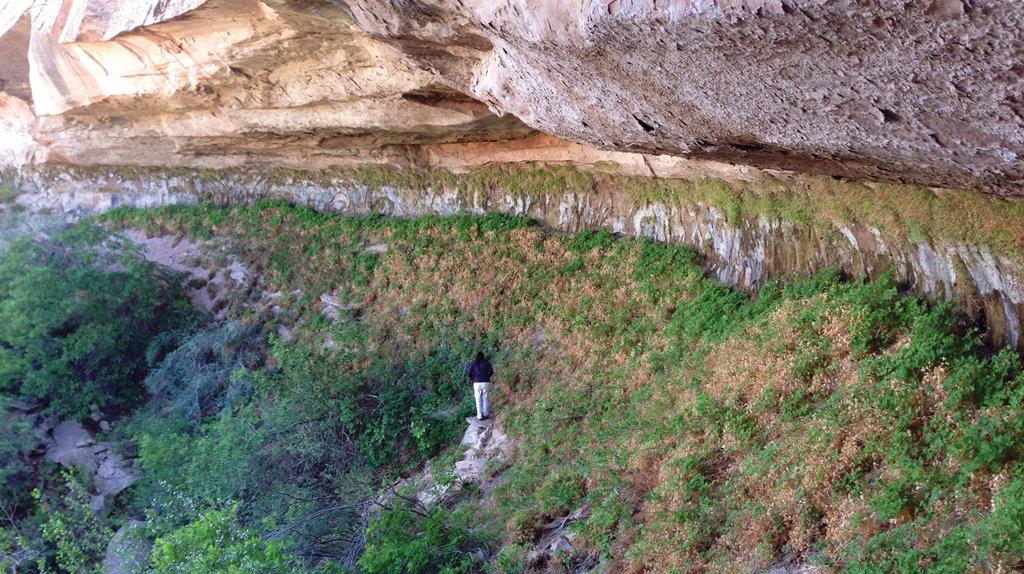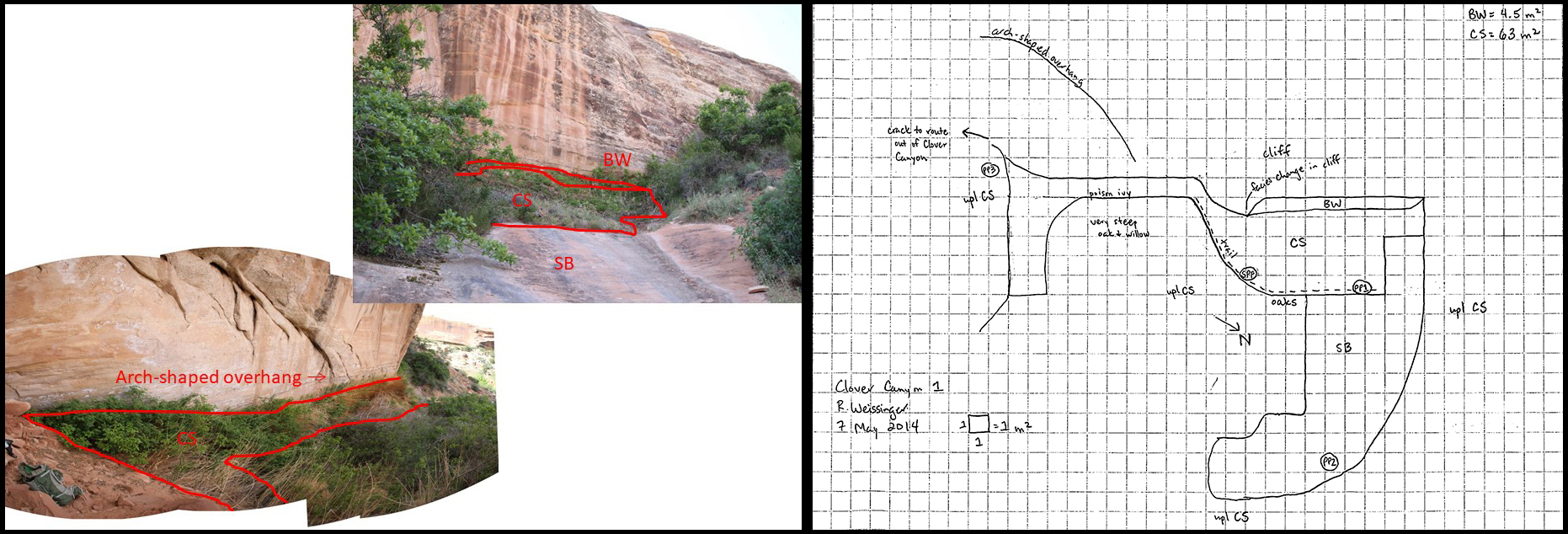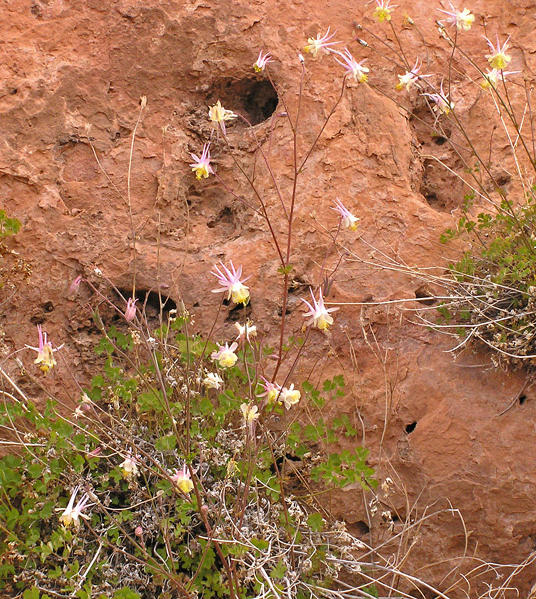Last updated: November 7, 2022
Article
Monitoring Hanging Gardens in National Parks of Southeast Utah, 2013–2020

Hanging garden, Arches National Park.
What are Hanging Gardens?
On the Colorado Plateau, springs support rich and diverse vegetation, including plant species known as endemics, found only in specific, localized areas. Often the only water source for many miles around, springs are also centers of human and wildlife activity. Yet these valuable sites occupy only a tiny fraction of the overall landscape.
Of that fraction, an even smaller portion is occupied by a spring type unique to the Plateau: the hanging garden. Hanging gardens develop at the contact point between highly permeable sandstones and less-permeable layers. They can be small, seasonal patches with little to no vegetation—or lush, plant-filled alcoves. These rare habitats are home to rare species: 8–9% of known endemic-plant species at Arches National Park and Natural Bridges National Monument are hanging-garden specialists.
Because of their importance to park resources and visitor experience, scientists with the Northern Colorado Plateau Network (NCPN) monitor the long-term health of springs at four National Park Service units. Hanging gardens are found in three of those units: Arches and Canyonlands national parks and Natural Bridges National Monument.
Key points
- Hanging gardens are home to 8–9% of known endemic-plant species at Arches National Park and Natural Bridges National Monument.
- More sites had endemic-plant populations of fewer than 100 individuals at the end of our record than at the beginning.
- Three of seven monitored species had a statistically significant decline in counts when small-population data were pooled across parks.
- Potential die-offs of some endemic species were seen at some sites, likely due to increasing drought.
- We anticipate additional drought stress and drying in hanging gardens and other springs in southeast Utah.
- NCPN monitoring methods will be tweaked to improve sampling efficiency.
First, Do No Harm
Tracking change in hanging gardens has turned out to be challenging. There are almost no published data on springs-vegetation monitoring in the arid Southwest. Most protocols focus primarily on characterizing springs at a point in time, rather than monitoring over the longer term. Faced with a scientific need, but no clear blueprint for how to proceed, NCPN ecologists and their partners found themselves in the challenging position of having to figure out for themselves how best to monitor hanging-garden health. They chose the number of endemic-plant species at a site as one indicator, because (1) their perennial populations don’t typically fluctuate from year to year based on climate conditions (like annual grasses do), and (2) they are good indicators of site wetness. Seven species were selected for monitoring: Rydberg’s thistle (Cirsium rydbergii), kachina daisy (Erigeron kachinensis), alcove death camas (Zigadenus vaginatus), alcove bog orchid (Habenaria zothecina), cave primrose (Primula specuicola), alcove columbine (Aquilegia micrantha), and Eastwood’s monkeyflower (Mimulus eastwoodiae).
But how to do the counts? Hanging gardens are fragile systems in precarious settings, often found at the top of steep slopes of slick bedrock or loose colluvium. Sampling intended to be performed over many years needed to be safe for field crews and avoid damaging the resources being studied. Pilot sampling in 2011 had used a systematic, quadrat-based method, in which the entire hanging garden was surveyed. But this approach raised concerns about safety and resource damage, and was discontinued.
Our current methods focus on geomorphic surfaces in accessible portions of hanging gardens, where traversing the sampling area will not displace plant roots or expose the field crew to serious falls. From 2013 to 2020, observers used a laser rangefinder to collect rough dimensions of the garden during an initial site visit; mapped separate geomorphic surfaces (backwall, alcove floor, and colluvial slope) onto graph paper; and took photographs showing the extent of the mapped area (see below).

Annotated photos and map of sampling area at Arches National Park. (Click to enlarge)
The map and photos were used to delineate the sampling areas. Observers recorded the number of endemic plants by species according to count classes for each sampling area, then calculated a total for the spring. Up to 500 individuals were counted for each species per geomorphic surface. Larger populations were estimated in count classes of 501–1,000, 1,001–10,000, and >10,000 individuals.
These methods were developed with the expectation that their usefulness would be evaluated after testing. Because of differing growth habits of the endemic species and the lack of a standardized search area, observer repeatability was a primary concern. Examining eight years (2013–2020) of data, a recent report investigates the success of these methods, and provides our first evaluation of status and trends at NCPN hanging gardens.
Repeatability of Methods
We investigated repeatability of the methods by comparing counts collected (1) by two separate observers during the same site visit and (2) during the first and second-year site visits (usually by the same observer). Because they are all perennial species, the number of plants typically doesn’t change much from year to year. Only Rydberg’s thistle had high repeatability in both double-observer and year-to-year count scenarios. In year-to-year count scenarios (see table), repeatability in count classes was less than 50% for kachina daisy and Eastwood’s monkeyflower, which both propagate vegetatively via ramets and/or stolons. The remaining species were categorized in different classes between 15–40% of the time. Double-observer comparisons (see table) were only available for 6.6% of the dataset, but suggested that (1) observer bias was present and (2) an observer with more experience working in hanging gardens generally had higher counts than an observer with less experience in this system.
Differences in year-to-year and double-observer classification at Arches and Canyonlands national parks and Natural Bridges National Monument, 2013–2020.| Species | Common name | Year-to-year classification | Double-observer classification | ||||
|---|---|---|---|---|---|---|---|
| Total classifications | Percentage | Total classifications | Percentage | ||||
| Same | Different | Same | Different | ||||
| Cirsium rydbergii | Rydberg’s thistle | 25 | 96.0 | 4.0 | 5 | 100.0 | 0.0 |
| Aquilegia micrantha | alcove columbine | 41 | 82.9 | 17.1 | 5 | 100.0 | 0.0 |
| Mimulus eastwoodiae | Eastwood’s monkeyflower | 50 | 82.0 | 18.0 | 11 | 72.7 | 27.3 |
| Zigadenus vaginatus | alcove death camas | 35 | 71.4 | 28.6 | 7 | 71.4 | 28.6 |
| Habenaria zothecina | alcove bog orchid | 27 | 66.7 | 33.3 | 3 | 66.7 | 33.3 |
| Primula specuicola | cave primrose | 31 | 64.5 | 35.5 | 5 | 60.0 | 40 |
| Erigeron kachinensis | kachina daisy | 10 | 40.0 | 60.0 | 8 | 50.0 | 50.0 |
| Total | – | 219 | 75.8 | 24.2 | 44 | 72.7 | 27.3 |
Although repeatability was variable, it was within the range reported by other studies for most species. Because of the large count classes, our methods are more sensitive to showing change in smaller populations (fewer than 500 individuals). Small populations are also of greatest concern to park managers because of their vulnerability to declines or extirpation due to drought. The NCPN will make some modifications to the protocol but will continue using endemic-plant counts as an indicator of hanging-garden health. Endemic-plant monitoring will continue for the five species with the highest repeatability (all except cave primrose and kachina daisy) and will focus on detecting changes in smaller populations. While endemic-plant count data may not be precise, this information is still important, given the ecological value of these unique systems.
 Alcove columbine (Aquilegia micrantha).
Alcove columbine (Aquilegia micrantha).Status and Trends
The distribution of endemic-plant populations in different count classes has not yet shown any statistical trends over our relatively brief period of record. Overall, more sites had endemic-plant populations of fewer than 100 individuals at the end of our record than at the beginning. Rydberg’s thistle and alcove bog orchid had the greatest proportion of small populations at monitoring locations. These two species, and alcove columbine, also had a statistically significant decline in counts when small-population data (<500 individuals in at least one count) were pooled across parks.
Starting in 2020, we also noted potential die-offs of some endemic species at some sites, particularly alcove bog orchid at Natural Bridges National Monument. For example, at one site, none of these plants were found in 2020, whereas previous counts had ranged from 48 to 183 individuals. This is likely due to increasing drought, as air temperatures continue to rise in the region. Drought effects were visible on other springs vegetation during site visits in 2020 and 2021. Spring-associated woody species, such as hackberry and chokecherry, have experienced canopy-browning and limb-shedding. Some individual woody plants recorded in photopoints have died.
We have also noted mortality in spring-associated species at the edges of hanging gardens. As climate change continues, we anticipate additional drought stress and drying in hanging gardens and other springs in southeast Utah, which will likely negatively affect endemic-plant populations at these sites.
Continued monitoring of hanging gardens can provide park managers with early detection of these changes, even when statistical trend detection lags behind.
Information in this brief was summarized from R. Weissinger, Evaluation of Hanging-Garden Endemic-Plant Monitoring at Southeast Utah Group National Parks, 2013–2020.
